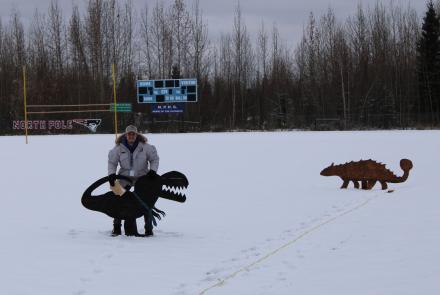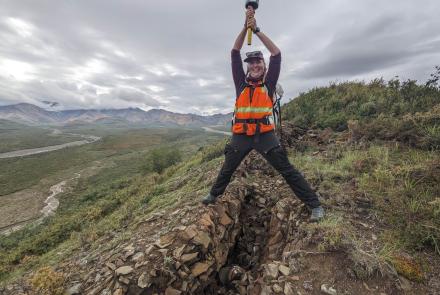Meet Ph.D. student Amy Hendricks
Just over 500 roadless miles southwest of Fairbanks, Alaska, sits the Kuskokwim River hub community of Bethel. The small spread-out city cradles a sweeping bend in the big river, which empties into the Bering Sea.
This part of Southwest Alaska is home to the Yup’ik and Cup’ik peoples who have occupied dozens of villages in this wildlife-rich tundra region for thousands of years. They have deep knowledge of the land, waters, fauna and flora.
Amy Hendricks, a University of Alaska Fairbanks Ph.D. student, needed to know what they were observing. She had been researching, through vegetation modeling, the impact of climate change on the region’s plant productivity.
She has made six trips to Bethel with her adviser, atmospheric sciences professor Uma Bhatt.
“We've been meeting with a group of elders to talk about our research into the climate of Southwest Alaska and the Yukon-Kuskokwim Delta and at the same time hear about their lived experience of how the climate has changed and impacted their lifestyles,” Hendricks said.
Those conversations have helped shape her climate research. They have also helped her detect in the hard data the same observations elders have made over so many years of living in the region.
Her research, she said, illustrates the possibilities available for graduate students in Alaska.
“Just being able to really bring the research to reality is something that graduate students at UAF have a lot of opportunity to do,” she said.
Alaska offers graduate students an extraordinary laboratory, from beyond the Arctic coast, to out on the waters of the Bering and Chukchi seas, to the slopes of Alaska’s mountains and volcanoes, to the glowing winter sky above — and much more.
As to her own story, Hendricks’ path to Alaska is one of many miles. Born on a U.S. Navy base in Okinawa, she and her parents soon moved to Minnesota, where she learned to appreciate the weather.
“There's a lot of really great severe weather that happens there,” Hendricks said. “But it's the mid-latitudes, where weather happens in a certain more-predictable way, and so the clouds carry a lot of messages. You can do a little forecasting on your own just by watching the clouds.”
“You'll see some cirrus clouds come in, so you know a front will come through in a couple of days and that it might rain,” she said.
And then it was back to Japan with her family, but she was there only for a year before returning to Minnesota, where she stayed until graduating from high school. She took several math and science classes, including physics.
The subject of weather stayed with her. And so did the Midwest. She earned her bachelor’s degree in meteorology from the University of Oklahoma, whose renowned School of Meteorology is housed within the National Weather Center.
A graduate degree wasn’t in her plans, but the 49th state was.
“I always wanted to be in Alaska,” she said. “So I looked up atmospheric or meteorology programs in Alaska, and UAF was the only one that had it.”
Hendricks finished her master’s degree in atmospheric sciences, with research into paleoclimatology.
For her master’s, she punched in data to obtain information about the type of biome that might have existed about 20,000 years ago in Beringia, the land and water area of today’s Siberia, Alaska and the northwestern portion of Canada’s Yukon.
She compared the results with data from the Holocene Thermal Maximum, which occurred about 8,000 years ago, and also ran a pre-industrial comparison and present-day and future scenarios.
Now it’s on to her Ph.D., which she says is a continuation of her vegetation modeling. Part of that work included researching climate drivers of plant productivity trends in Southwest Alaska.
Something seemed odd in the results.
“Unlike the rest of the circumpolar Arctic — where we’re seeing more productive plants, bigger leaves, shrubs moving into areas due to warming temperatures — Southwest Alaska was popping up in satellite images as doing the opposite,” Hendricks said.
“There was this negative trend, even though temperatures were still warming,” she said
What did the research show?
“What we found was that vegetation productivity trends are actually tied to the Bering Sea spring sea ice concentration,” she said.
Hendricks said it's an exciting time in climate science.
“Now that we’ve got more than 40 years of data, we're able to start to see some of these low-frequency patterns that we haven't been able to see until now,” she said. “We can start to get these deeper understandings of how the Arctic climate system really interacts with itself.”
UAF is a great place to earn a doctorate, she said.
“You can really take your research and do something with it.”
Rod Boyce, University of Alaska Fairbanks Geophysical Institute, 907-474-7185, rcboyce@alaska.edu




